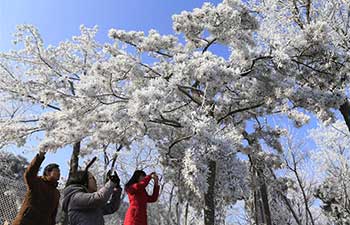SYDNEY, Jan. 24 (Xinhua) -- A new population of what is considered the world's rarest fish has been discovered off the southeast coast of Australia's Tasmania island, Australian researchers said on Wednesday.
The red handfish were spotted last week at an area about the size of two tennis courts, a number of kilometers away from a previously known population of about 20 to 40 individuals in Tasmania's Frederick Henry Bay, said researchers at the Institute for Marine and Antarctic Studies based in the island state's capital Hobart.
"There used to be more populations known... across southeastern Tasmania, but over the last 15 years there's only been the one population known and we've been monitoring that," institute scientist Dr. Rick Stuart-Smith told Xinhua.
"We received a report of a sighting somewhere else. We checked out that location and found eight individuals there and estimate a population of a similar size, effectively that doubles how many we know are left on the planet."
Handfish, which are endemic to Australia and can grow up to 15 cm long, have a slow, distinctive way of moving, by using their side fins to "walk" on the seafloor rather than swim. Red handfish grow to about 9 cm.
"Determining trends in red handfish populations is difficult because the species is small, cryptic and extremely rare," according to Australia's Department of the Environment and Energy.
A team of seven divers spent two days searching for the fish at the new site after a member of the public spotted an individual specimen there and the exact location "will not be disclosed until management options can be discussed," said the institute.
"We've learnt a lot from discovering this second population... we can reduce the impacts that humans place on them to hopefully help them persist as long as possible," said Stuart-Smith.
"Maybe an exclusion zone for boating in the shallow location, the new one discovered," he said.
"The other location, we believe habitat loss is one of the key threats. In part, this may be due to the sea urchins that are eating the seaweed that the fish need to hide in and to lay their eggs on. The sea urchins are increasing in numbers because there's very few rock lobsters on the reef. Protecting the rock lobsters on that patch of reef will likely be helpful to maintain that habitat," he added.
The new finding also means that captive breeding may be possible for the fish, he said.
"As a conservation action, to help tank-raise the young ones and reintroduce them, it was a risky scenario. But we've got more information to work with now and we can discuss that opportunity again."
Tasmania, known for its pristine environment, is a global hotspot for this family of rare and endangered species, said Stuart-Smith.
The Spotted Handfish is still observed around Hobart, but it may be too late to find Ziebell's Handfish, a third species listed as endangered. Researchers will work with the government and other groups to help inform management options for the handfish sites, he added.

















